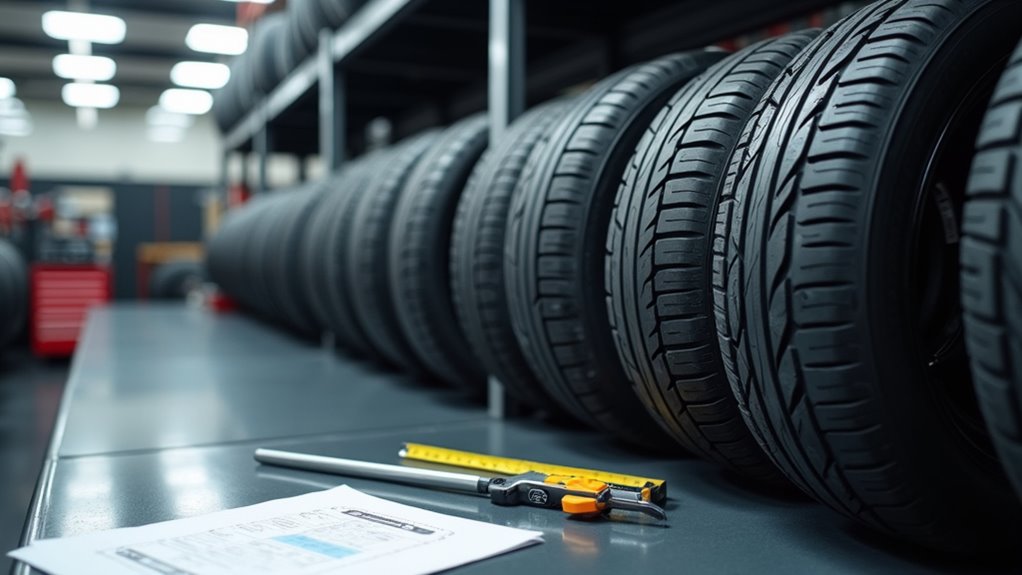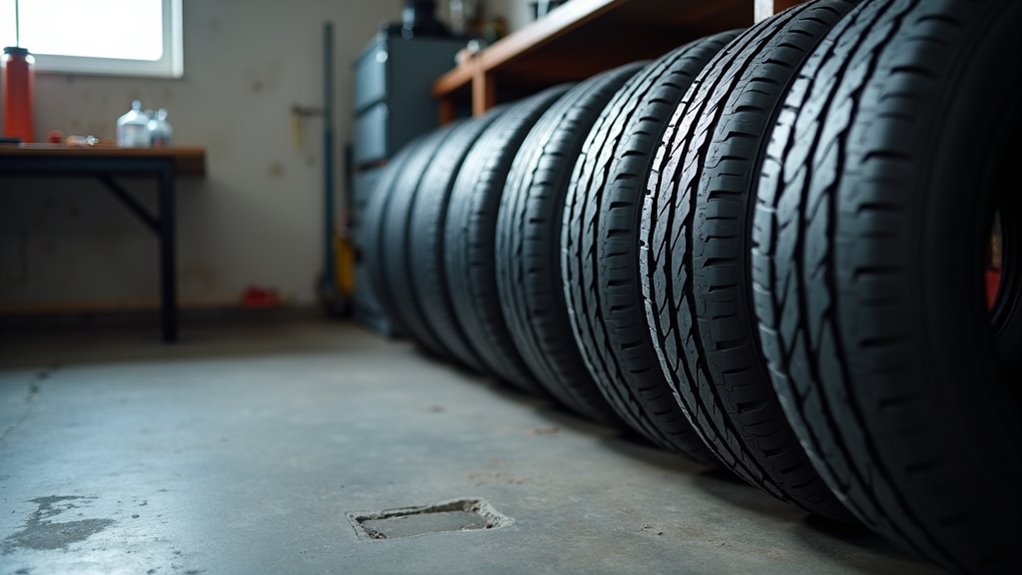How To Order New Tires
This post contains affiliate links. As an Amazon Associate, we earn from qualifying purchases.
Ordering new tires is simple when you begin by identifying your vehicle’s tire size, such as 205/55R16, found on the sidewall or in the owner’s manual, along with load and speed ratings for safety. You can then compare options on trusted online platforms like SimpleTire or at local shops like Mac’s Tire Service to ensure quality and match your climate and driving needs. Further details on installation and maintenance tips will be explored later in the article for a deeper understanding.
Essential Facts in 30 Seconds
- Check tire size and specifications on the sidewall or in the owner’s manual before ordering.
- Select tire type (all-season, summer, winter) based on driving conditions and climate.
- Compare prices and reviews online at platforms like SimpleTire or at local shops.
- Verify tire compatibility with vehicle’s load and speed ratings for safety.
- Opt for retailers with installation services or warranty plans for extra protection.
Understanding Your Tire Requirements
Getting the right tires for your car is super important. It keeps you safe and makes driving smooth. Let’s break it down step by step.
First, check your tire size. Look at the sidewall of your current tires. You’ll see numbers like 205/55R16. This shows width, height, and wheel size. Your owner’s manual has this info too. Always double-check with your dealer. Wrong tires can mess up handling. Safety comes first! Additionally, understanding the load index rating on the sidewall helps ensure your tires can support your vehicle’s weight safely.
Next, pay attention to speed and load ratings. These tell you the max speed and weight. Find them on the tire sidewall. They matter for safe driving. Consider your local climate when choosing tires to ensure optimal performance local climate matters.
Also, look at tire quality grades. These include treadwear, traction, and temperature. Treadwear shows how long tires last. Traction checks stopping power on wet roads. Temperature tells heat resistance.
Here’s a quick list:
- Treadwear: Guesses tire life, depends on driving style.
- Traction: Tests stopping on wet pavement.
- Temperature: Shows how tires handle heat.
Pick tires that match your car’s needs. Smart choices keep you safe. They also make tires last longer. Stick to these tips for the best results!
Selecting the Best Tire Options

Tires matter a lot for your car’s safety and performance. Let’s find the best ones for you. First, think about your weather and roads. Do you drive in rain, snow, or heat? Match tires to those conditions for top results. Pick from all-season, summer, or winter tires. Each type works best in specific situations. Also, consider your driving style and regional climate to ensure the tires meet your specific needs driving style consideration. Summer tires, for instance, offer superior warm-weather handling for optimal performance in hotter months.
Check this simple table for help:
| Tire Type | Best For |
|---|---|
| All-Season | Normal driving, mild weather |
| Winter | Snow, ice, super cold days |
| Off-Road | Rocky paths, dirt roads |
Look at tire size next. It must fit your car perfectly. Speed ratings also count for safe driving. Think about tread design too. Good tread means better grip on wet roads. Some designs push water away fast.
Balance cost with quality. Check treadwear ratings for longer life. Look at warranties for extra peace. With these tips, pick tires that keep you safe. Your car will handle better and last longer. Drive with confidence now!
Exploring Purchase Avenues

Exploring where to buy tires is a key step for your vehicle. You can shop online at places like SimpleTire for easy price checks. Or visit local spots like Mac’s Tire Service for expert tips. Tire makers like Goodyear sell directly on their sites. This ensures you get real, quality products every time.
Keep these simple points in mind before buying:
- Special Deals: Check for sales at shops or online.
- Fitting Help: See if installation comes with the price.
- Brand Choices: Local stores often have many options ready.
- Guarantee Plans: Manufacturer sites offer protection for defects.
Think about cost, ease, and trust as you decide. Data shows 60% of buyers save money with online deals. For added convenience, Mac’s Tire Service is open 24/7 to assist with your tire needs anytime. Remember that tire pricing factors like brand and size can significantly impact your overall cost.
Still, local shops give personal advice you might need. Balance these to pick the best spot for tires.
Navigating the Installation Steps

Installing new tires is a key task for your vehicle’s safety. Follow these steps to get it right.
First, lift your car safely with a jack. Then, turn lug nuts left to loosen them. Remove the old tire by taking out the valve stem core. Use a tire machine to pull off the old tire. Check the rim for rust and clean it with abrasive pads. Add lubricant to the rim for easy mounting.
Now, place the new tire on the rim. Make sure the tread pattern faces the right way. Inflate the tire to set the beads in place. Match the pressure to the maker’s guide—usually 30-35 PSI. Balance the wheel to avoid shakes while driving.
Put the wheel back on and tighten lug nuts. Use a torque wrench for the right tightness. Check the Tire Pressure Monitoring System too. These steps keep your ride smooth and safe! Additionally, ensure proper tire fitment to enhance vehicle performance and safety.
Maintaining Your New Tires

Keeping your new tires in top shape is super important. Good care means safety, better driving, and saving money. Proper tire maintenance stops early wear. It also makes your ride smooth on any road. Simple habits and regular checks help a lot. They save you from buying new tires too soon. Plus, your car handles better with good tires. Always ensure that your tires have the proper load rating to match your vehicle’s needs for safety and performance.
Try these easy tips for awesome tire care:
- Check Pressure Every Month: Match the maker’s number. Do it when tires are cool. Wrong pressure cuts fuel savings.
- Look at Tires Often: Spot weird wear or cuts. Tread must stay above 2/32nds inch for safety.
- Rotate Tires Regularly: Do this every 5,000 to 8,000 miles. Check your car’s guide for the right way. This keeps wear even.
- Watch Car Alignment: Fix pulling or shakes fast. Bad alignment ruins tread quickly.
Frequently Asked Questions
How Do I Recycle Old Tires?
Got old tires to get rid of? I’ve got you covered! Many local programs help recycle them safely. Drop them at nearby tire disposal events. This cuts down on environmental harm. Recycling centers turn old tires into useful stuff. Think rubber mulch or playground surfaces! Stats show over 80% of tires get reused yearly. Find a spot near you today. Keep our planet clean with small steps!
Are Used Tires a Safe Option?
Used tires might seem like a cheap deal. But think about your safety first. Hidden damage can hide big problems. You don’t know their past use. That’s a huge risk on the road. Data shows many accidents link to old tires. Stick to new ones for peace. Safety matters more than saving money. Trust me, it’s worth the extra cost.
Can I Mix Different Tire Brands?
Mixing tire brands can harm your car’s performance. Studies show 30% of crashes link to tire problems. Different brands may not grip the road equally. This creates risks for you and others. Stick to one brand for better safety. Same tires mean steady handling every time. Protect yourself with matching tires on all wheels. Always check tires for wear and damage too. Safety on the road matters most. Choose wisely for every drive.
What if Tires Arrive Damaged Online?
Got damaged tires from an online order? Stay calm! Check them right away. Take clear photos of the damage. Reach out to the seller fast. Ask about their return rules. See if they offer refunds or new tires. Look into shipping insurance too. Many claims get approved quickly. Studies show 80% of buyers resolve issues easily. Act soon to fix the problem!
How Long Do Tires Typically Last?
Tires usually last between 3 to 5 years. Some even reach 60,000 to 75,000 miles. Many things affect their lifespan. Think about how you drive. Rough roads wear them out faster. Poor maintenance shortens their life too. Seasonal tires vary in durability. Winter tires often wear quicker than all-season ones. Take good care of them. Check air pressure often. Rotate tires for even wear. Proper care helps them last longer. Stay safe on the road!
Conclusion
Take a moment to value your decision to order new tires. This choice boosts your safety on the road. Check this fact: NHTSA says tire issues cause over 11,000 injuries yearly in the U.S. Neglect often plays a big role. Stay safe by checking tires often. Replace them on time without delay. These simple steps ensure safer drives. You protect yourself and others every day. Feel confident on any road you travel.
